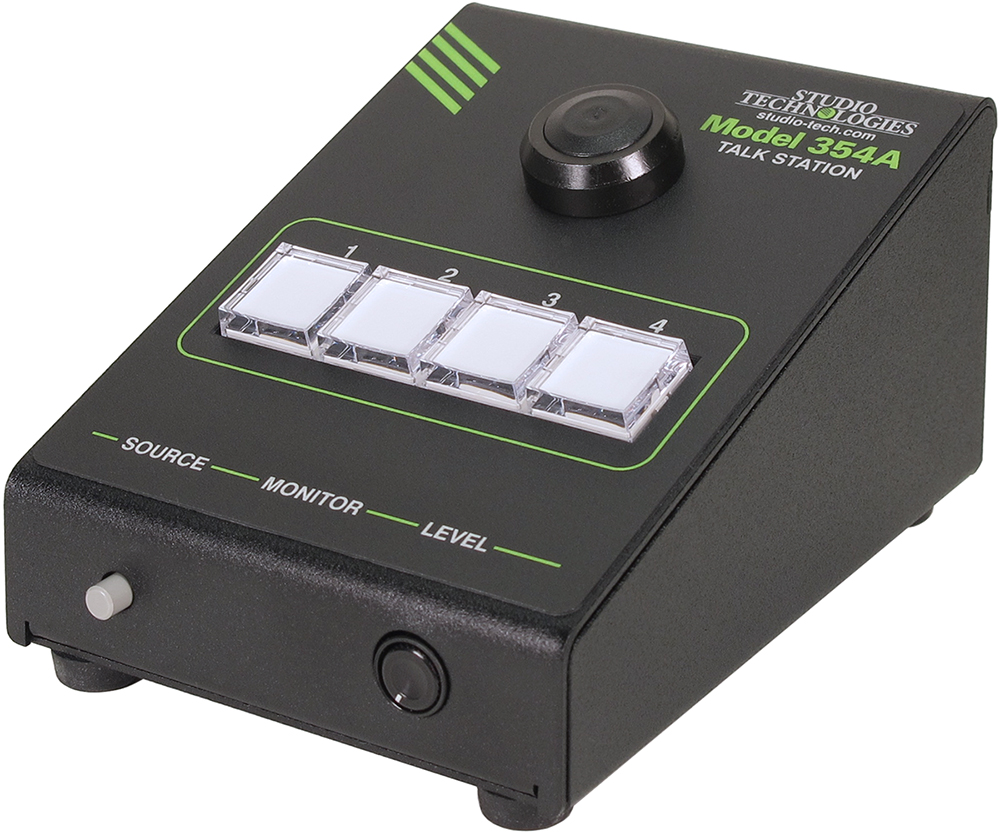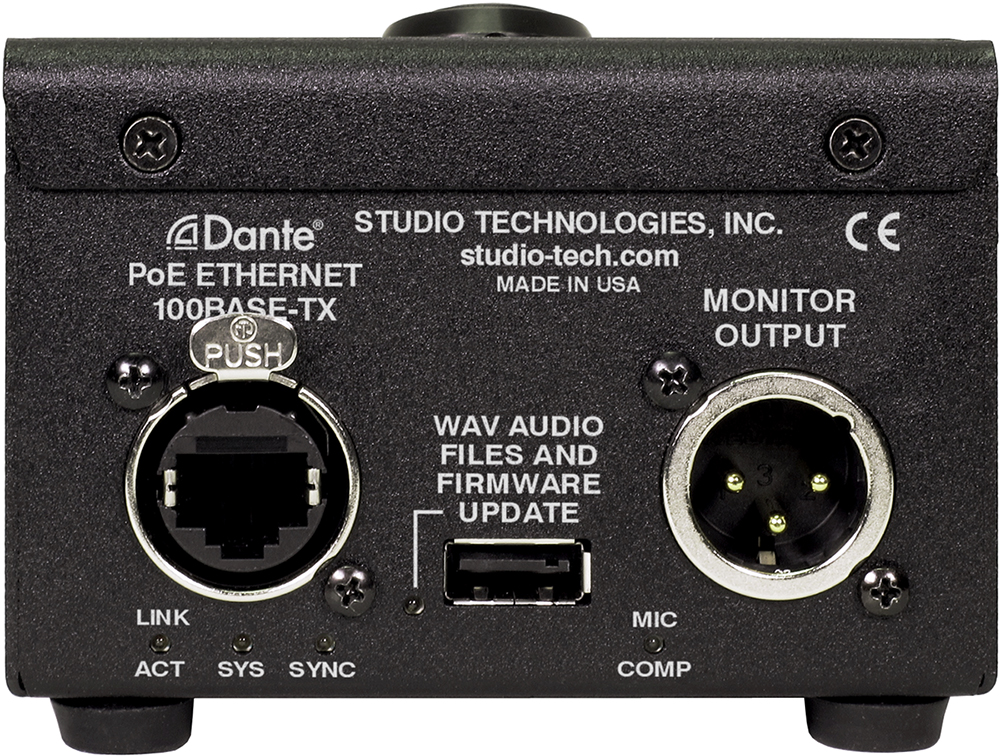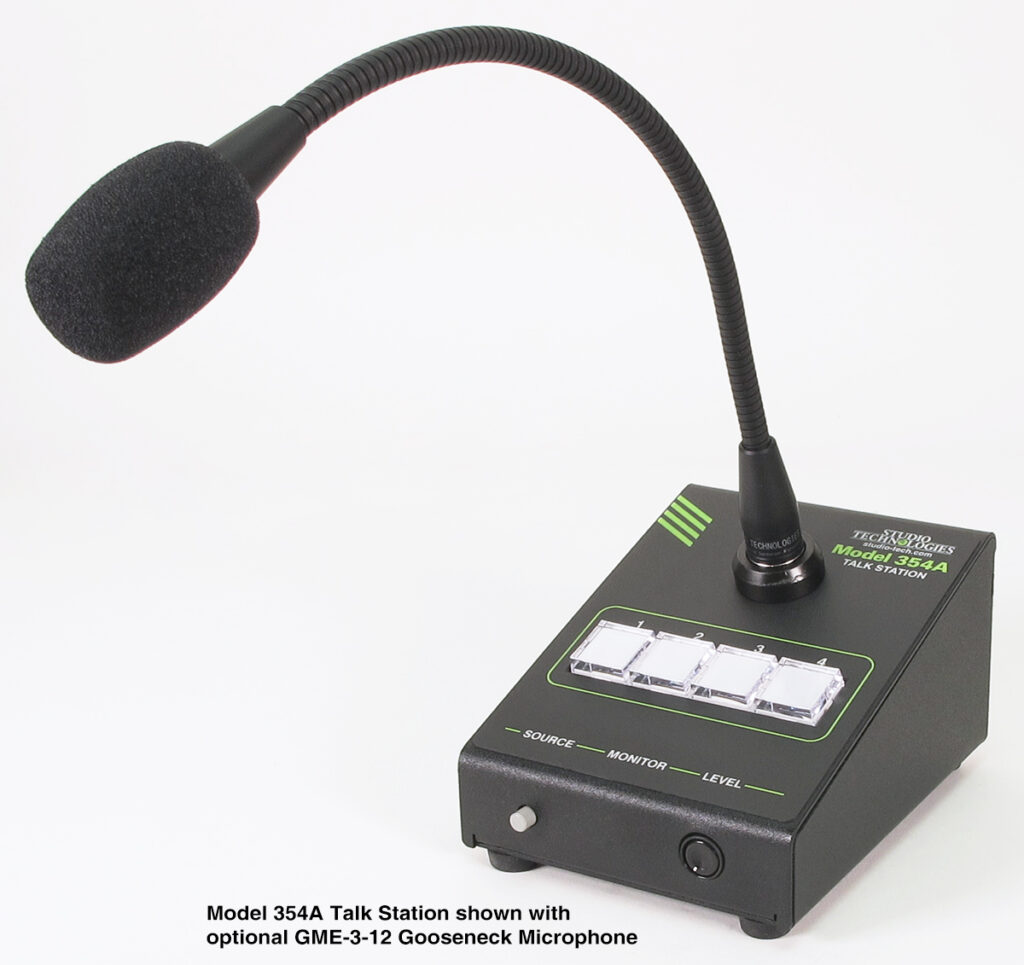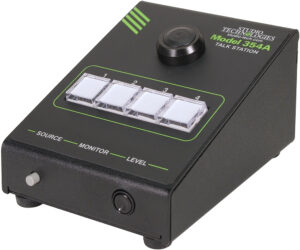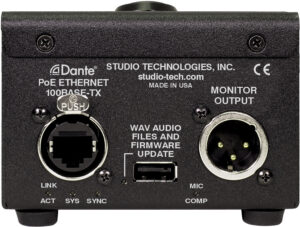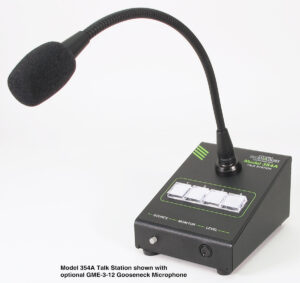The Model 354A Talk Station is a unique product intended to support a variety of voice paging, background music, audio-file playback, broadcast talent cueing (IFB), and general-audio applications. The unit supplies four independent "talk" channels that can be individually configured to match the needs of an application. A monitor section allows one of the four Dante® receiver (input) channels to be routed as desired to a connected amplifier or amplified speaker.
The Model 354A supports Dante audio-over-Ethernet digital media technology with AES67 compatibility for integration into contemporary applications. In addition, the unit is compatible with the Dante Domain Manager™ (DDM) software application.
Voice audio is supplied by way of a gooseneck microphone, purchased separately, which is attached to the connector/threaded bushing combination that is located on the front of the Model 354A. (Using the Studio Technologies' GME-3-12 Gooseneck Microphone is highly recommended.) Two audio sources or "messages," up to 40 seconds each in length, are stored in non-volatile memory within the Model 354A. These two audio sources, saved in the common 16-bit monoaural WAV format, can be easily updated by way of a standard USB flash drive. The audio files can contain whatever "pre-page" (preamble) audio signals that are desired to support an application. They could be the sound of natural bells or chimes, an "electronically created" audio sequence, or a voice message. By using WAV files, the desired sources can be created outside of the Model 354A and then easily loaded for use. Configuration choices determine how and when the preamble audio files will be played.
The Model 354A is extremely simple to deploy, is "pro" quality throughout, and provides an intuitive user experience. The Model 354A's audio quality is excellent, with low distortion, low noise, and ample headroom. Careful circuit design and rugged components ensure long, reliable operation. Only a Power-over-Ethernet (PoE) connection and attachment of a gooseneck microphone are required for operation. If desired, the analog monitor output can be connected to the input of an associated device. Two "custom" WAV audio files can be loaded by way of a USB flash drive.
Model 354A operating features are configured using the STcontroller software application. An extensive set of parameters allows the unit's functions to be tailored to meet the needs of a myriad of applications. STcontroller is a fast and simple means of confirming and revising the unit's operating parameters. The Model 354A is housed in a compact, rugged steel enclosure that's intended for table-top use. Its small size makes it ideal for applications in space-constrained locations.
Applications
For theater or live-event spaces the Model 354A can be a complete solution for routing up to four channels of background audio with voice paging and preamble audio capability. Pre-recorded "tones" or "chimes" can be configured to play prior to voice audio being presented to one or more of the outputs. The unit could be located in a box office or manager's office location.
A Model 354A function allows high-frequency "call" audio signals present in a Dante receiver (input) channel to be detected and displayed in the LED indicators associated with a pushbutton switch. This allows users to observe the on or off status of call signals that may be associated with intercom audio channels. In addition, this function can be used to display when a channel is active. This allows multiple Model 354A units to be deployed in a single application, with each unit displaying the talk status of all the others. A configuration option allows an associated pushbutton switch to be disabled whenever talk activity is taking place in other units. This feature will help prevent multiple users from simultaneously activating a talk function.
Broadcast applications can utilize the Model 354A to create a simple 4-channel talent cue (IFB) master station. "Program" audio sources can be routed to the unit's Dante receiver (input) channels and then interrupted with gooseneck microphone audio as desired.
Deployment of Dante applications could benefit from the unit's ability to store and playback WAV audio files. Test messages could be created in WAV format and then loaded into the Model 354A for continuous playback during system commissioning.
Security or management personnel could use the Model 354A as a combination voice paging console and monitor resource. Audio from the gooseneck microphone can be routed to up to four Dante transmitter (output) channels. The monitor section allows one of the four Dante receiver (input) sources to be monitored using a connected amplifier or amplified speaker.
The range of resources provided by the Model 354A also makes it suitable for use in many other applications. It's designed to support the needs of varied applications across a wide range of audio system designs. The unit is intended to provide a "palette" of resources that meet real-world needs, allowing great things to be accomplished rather than presenting limitations that dictate what can and can't be done.
Setup and Operation
Set up, configuration, and operation of the Model 354A is simple. An RJ45 jack is used to interconnect with a standard twisted-pair Ethernet port associated with a PoE-enabled network switch. This connection provides both power and bidirectional digital audio. A gooseneck microphone is attached using the 3-conductor ¼-inch jack with integrated threaded bushing. The Studio Technologies' GME-3-12 Gooseneck Microphone is available as an option and will perform very well with the Model 354A.
The monitor output (available in both analog and Dante digital formats) can assist the user in confirming system operation. A 3-pin male XLR connector provides access to the analog monitor output. This would typically be connected to the input on an amplified loudspeaker. One or two "custom" preamble audio files can be created and loaded into the Model 354A. They utilize the common WAV file format supported by many personal computer applications. The STcontroller software application is used to configure the wide range of Model 354A operating parameters. This allows the unit's performance to be optimized to meet the needs of specific applications.
The user is presented with five pushbutton switches and a push-in/push-out rotary level potentiometer. Four of the pushbutton switches are lighted with dual-color LEDs to represent the unit's operating status.
Ethernet Data and PoE
The Model 354A connects to a local area network (LAN) by way of a 100 Mb/s twisted-pair Ethernet interface. The unit's physical 100BASE-TX interconnection is made by way of a Neutrik® etherCON® RJ45 jack. While compatible with standard RJ45 plugs, an etherCON CAT5-compatible plug allows a ruggedized and locking interconnection for harsh or high-reliability environments. The Model 354A's operating power is provided by way of the Ethernet interface using the 802.3af Power-over-Ethernet (PoE) standard. This allows fast and efficient interconnection with the associated data network. To support PoE power management, the Model 354A's PoE interface enumerates (reports) to the power sourcing equipment (PSE) that it's a class 1 (very low power) device.
Dante Audio-over-Ethernet
Audio data is sent to and received from the Model 354A using the Dante audio-over-Ethernet media networking technology. As a Dante-compliant device, the Model 354A's four Dante transmitter (output) channels and four Dante receiver (input) channels can be assigned (routed or "subscribed") to other devices using the Dante Controller software application. The Dante transmitter (output) and receiver (input) channels are limited to supporting four Dante flows, two in each direction. The digital audio's bit depth is up to 32 with a sampling rate of 48 kHz. Two bi-color LEDs provide an indication of the Dante connection status. An additional LED displays the status of the associated Ethernet connection.
The Model 354A is compatible with the AES67 interoperability standard. When configured in Dante Controller to support AES67, the unit's four transmitter (output) channels will function in multicast; unicast is not supported. In addition, the Model 354A is compatible with the Dante Domain Manager (DDM) software application.
Audio Quality
The Model 354A provides excellent audio performance. A low-noise, wide dynamic-range microphone preamplifier and associated voltage-controlled-amplifier (VCA) dynamics controller (compressor) ensures that gooseneck microphone audio quality is preserved while minimizing the chance of signal overload. The output of the microphone preamp and compressor is routed to an analog-to-digital conversion (ADC) section that supports a sampling rate of 48 kHz with a bit depth of up to 32.
As previously discussed, the Model 354A can store and replay two audio files. These uncompressed PCM audio signals utilize the high-quality 16-bit, monaural, WAV format.
Audio sources can arrive in the Model 354A by way of four Dante receiver (input) channels. The supported sampling rate is 48 kHz with a bit depth of up to 32. These signals pass into the Model 354A's 32-bit microcontroller integrated circuit and can be used as part of background music or talent cue channels. They can also be used in conjunction with the analog and Dante monitor output functions. The source selected for the analog monitor output is sent to a high-performance digital-to-analog (DAC) integrated-circuit converter and then on to robust balanced (differential) output circuitry. The analog monitor output is protected from connection with low-voltage DC, ESD ("static"), and other potentially damaging transients.
The audio content of the Dante transmitter (output) channels will consist of, depending on the unit's configuration and operating state, a combination of gooseneck microphone, WAV audio file, and Dante receiver (input) sources. The signals remain in the digital domain and are routed through the 32-bit logic circuitry and on to the Dante interface section where it is packetized and prepared for transport over Ethernet.
Configuration Flexibility
The Model 354A can easily be configured to meet the needs of many specific applications and user preferences. All configuration choices are performed using the STcontroller software application. Versions of STcontroller are available to support the WinOS® and macOS® operating systems. Selectable configurable parameters include microphone preamplifier gain, WAV file level trim, LED indicator intensity and actions, and monitor output source selection and operation. In addition, each of the four Dante transmitter (output) functions can be optimized from the six available configuration choices. These choices allow the unit to be configured to support voice page, talent cueing (IFB), and other specialized applications.
As previously described, the functions associated with the four talk pushbutton switches and Dante transmitter (output) channels can be individually configured. As an example, for a voice page application three of the output channels might be configured to utilize a background music source and play, before the microphone is active, a pre-page message. The fourth output channel might be used as a voice-page output with no background music or pre-page audio. The four talk pushbutton switches would typically be configured to provide a momentary (push to activate) function.
Red and green LEDs are associated with the unit's four talk pushbutton switches. When lit singly they will provide a red or green indication. When both are lit simultaneously, they will provide an orange indication.
A configuration choice allows selection of how the LEDs will light under various operating conditions. This capability is provided to assist users who have trouble observing the differences between colors, typically issues differentiating between red and green. The "color blindness" condition is not uncommon in men and can make effective use of some electronic equipment difficult. The Model 354A's ability to control the talk pushbutton switches' colors can also be useful for supporting international applications where compliance to specific regulatory requirements is required. This may dictate which LED color is associated with a function being "on" and which color is associated with a function being "off."
The four Dante receiver (input) audio sources and the way in which they are assigned to the monitor output functions can be configured from among six choices. These unique choices allow a number of audio monitoring situations to be implemented. Whether for use in voice paging, talent cueing (IFB), or other audio applications, the Model 354A should be able to achieve the desired configuration. Several special functions allow the WAV files and gooseneck microphone audio to be routed to the analog, and, if enabled, Dante digital monitor outputs. Configurable using STcontroller, these functions can allow a user to hear confirmation audio related to the unit's real-time operation.
Future Capabilities and Firmware Updating
The Model 354A was designed so that its capabilities and performance can be enhanced in the future. The unit implements a USB host function which allows the application firmware (embedded software) to be updated using a standard USB flash drive. And, as previously discussed, the USB receptacle is also used to load WAV audio files that can be stored on the same USB flash drive. The Model 354A uses the Audinate UltimoX4™ integrated circuit to implement its Dante interface. The firmware in this integrated circuit can be updated via the Ethernet connection, helping to ensure that the unit's capabilities remain up to date.

